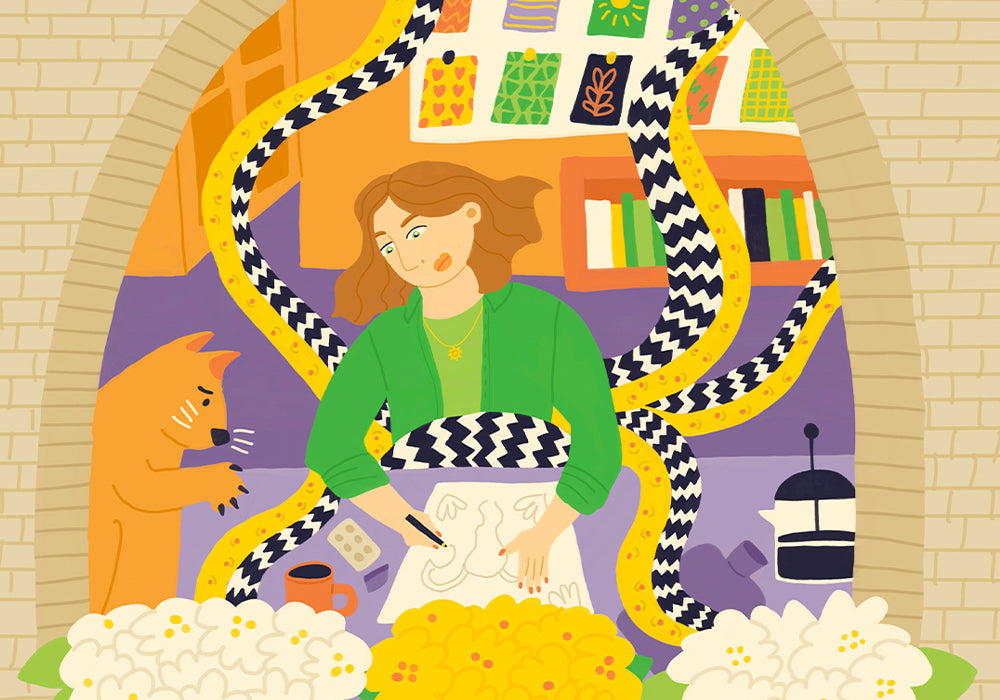How an Artist Transformed Period Pain Into Art
Endometriosis crept up on me unexpectedly. I can’t remember exactly when I realized that my period pain was abnormal and my mental health swings more severe than regular PMS.
At night, I remember waking up because my abdomen was throbbing with period pain and, in the morning, weeping uncontrollably at the mercy of my unbalanced hormones.
When I eventually managed to speak to a doctor about my pain, they asked how much it hurt on a scale from 1 to 10. I said 8 or 9, but didn’t feel a number described it sufficiently. I’m an illustrator and perceive the world visually.
 (Illustration by Justyna Green)
(Illustration by Justyna Green)
Numbers and words, to me, can be limiting when describing personal and visceral states. That’s why, over time, I started to draw characters suffering from period pain.
I pictured their abdomen tangled in a knot of thick, black, and white tentacles, to illustrate how severe the pain was and how it felt. When menstruating, I felt overcome with pain spreading from my abdomen through my whole body, also affecting my mental state.
Those illustrations helped me understand my pain, and when shown to family and friends, helped communicate what I was going through.
But, for the first doctor I saw, they didn't convey my pain. To her, it was just a bad period, and our conversation left me shaken and misunderstood. As I researched endometriosis more, I realized many women have similar experiences.
In the end, my journey to diagnosis took two years. I illustrated it along the way to process what I was going through and record just how hard it can be to get diagnosed and feel understood.
When I received my diagnosis, I was filled with anger. I was angry with myself, my body, and my womb, for failing me — for being weak and ridden with endometrial tissue. Luckily, over the years, to manage my mental health, I learned about the power of meditation and visualization.
Knowing that endometriosis is a long-haul journey — currently there’s no cure — I was determined to maintain a positive outlook.
To do that, I’ve resorted to visualizations: picturing in my mind’s eye and drawing beautiful wombs, fallopian tubes, ovaries, and the whole reproductive system — growing like the most beautiful plant you’ve ever seen. These meditative illustrations helped me create a loving connection with my body, instead of turning against it.
Whilst cultivating a positive relationship with my body, my endometriosis journey remained unbearable — from not being able to mention periods in my workplace to doctors refusing gynecological referrals, and the uncertainty around fertility and treatment.
I thought about my suffering and the fact that 1 in 10 women worldwide have endometriosis. It empowered me to speak up and share my story. So, I published my first comic Living with Endometriosis.
It was met with an outpouring of messages, emails, Instagram comments, and social media shares. Creating it was a cathartic personal experience, but seeing it resonate with so many women around the globe brought a further purpose to my work.
It became a way to raise awareness of endometriosis, to make people who suffer from it feel less alone, and to help their families and friends understand how debilitating living with the condition can be.
That’s why my journey with endometriosis art continues. I have now created a comic zine called Raw, which follows the character’s journey from first experiencing severe period pain to her diagnosis.
Through my work, I want to create an in-depth account of living with endometriosis, raise awareness, normalize talking about periods, and provide comfort to the 1 in 10 among us.
And I’m dreaming big, because how amazing would it be to see an animated series on Netflix talking about periods, endometriosis, and fertility trepidations, in a kind, empathetic, and uplifting manner?
I’d watch it, and I’m sure the estimated 190 million women around the world suffering from endometriosis would do too.
Justyna Green is an Illustrator and endometriosis advocate based in London.








